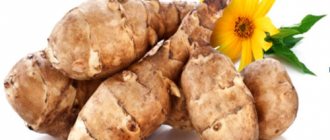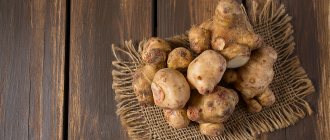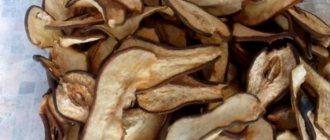Ground pear - you can eat it!
Jerusalem artichoke owes its origin to North America, and its name to the local Jerusalem artichoke tribe, which cultivated it for a long time and successfully. At the beginning of the 17th century, the French traveler Samuel Champlain introduced this vegetable to Western Europe, and only by the middle of the 18th century did it begin to be cultivated in Russia. However, it has not received widespread popularity and distribution among farmers (and even amateur gardeners) to this day.
But it’s completely in vain. Both the tubers and leaves of the plant are very rich in iron and silicon, folic acid, and for people with diabetes it can be just a godsend . Inulin contained in the roots allows you to completely replace artificial sweeteners for diabetics. Ground pear, Polish walnut, Peruvian aster - these are all synonyms for Jerusalem artichoke.
The advantages of cultivation on a production scale are considered to be its excellent frost resistance (down to minus 40 ° C), drought resistance, and adaptability to almost any type of soil, except solonchaks. The above-ground part is an excellent food for animals, and a wide variety of preparations for the winter can be made directly from Jerusalem artichoke.
How to prepare Jerusalem artichoke for the winter - recipes for canning and freezing
When fresh, thoroughly washed and dried earthen pear tubers are stored in the cellar for no more than a month, and then very quickly lose moisture. The best option in this case would be to freeze the Jerusalem artichoke in the freezer. Dry roots are packaged in separate plastic bags and frozen for the winter. They are then placed in a container of cold water to thaw before use.
Before harvesting, peel the selected roots and place them in a container with water. This way they will be even juicier.
To prepare the salad, take 1 kg of Jerusalem artichoke, 0.5 kg of onions and carrots. We clean and cut them. Then prepare the marinade: add 40 g of salt, black pepper, 50 g of table vinegar per liter of water. Boil for 5–7 minutes. Vinegar can be replaced with one lemon, cut into slices with skin. Pour the boiling mixture over the vegetables placed in sterilized jars, pasteurize for 15–20 minutes at 90 °C and close tightly with lids. To give the dish a more piquant taste, you can add 2 tbsp to the marinade. spoons of honey.
The salad can also be prepared without marinade, but the preparatory work will take a little more time. Ground pear, onion, carrots in the same proportions are finely chopped or grated on a coarse grater, salted, lemon grated with zest is added to the mixture and left for some time (about 12 hours) until the juice is released. Then they are put into containers and preserved. If you want to add some spice, you can add one hot pepper to the mixture.
Description of preparation:
Jerusalem artichoke itself has a somewhat neutral taste and smell. But thanks to the addition of honey and lemon, it turns out sweet and sour with a pleasant aroma. Jerusalem artichoke, like potatoes, tends to darken after peeling, so you need to immerse it in cold water. If the tubers are wilted, keep them in cold water for 10 hours. This jam must be stored in the refrigerator and is best covered with nylon lids.
Main ingredient: Vegetables / Jerusalem artichoke Dish: Preparations / Jam
Delicious preparations and unusual recipes
Pickled Jerusalem artichoke will also be delicious. In order to preserve iron and potassium in the vegetable as much as possible, it is carefully washed, but the skin is not cut off. It does not affect the taste in any way, only the color of the dish itself may not be a very beautiful grayish shade. Cut the tubers into thin slices and place them in jars, enamel or ceramic containers. Fill with saline solution - you will need 40 g of salt per liter of water. Cover the containers with lids and leave in a cool place until the end of fermentation. After about 2 weeks, pickled Jerusalem artichoke can be used as a side dish for fish dishes, added to vinaigrettes and salads.
Jerusalem artichoke jam is a very unusual dessert, the recipe for which is quite simple. You will need:
Mix the chopped ingredients and wait until the juice is released. Then bring the resulting mass to a boil. The future dessert should be cooked for no more than 5 minutes, after which we pour the jam directly from the stove into pre-prepared jars. Next is the standard procedure for sealing with metal lids. The dessert should cool in a warm place. In winter, it is very tasty and healthy to use this jam as a filling in yeast pies. If you have any pumpkin left over during the process, cook pumpkin compote - another representative of healthy cuisine!
If you like dried fruits, you can also prepare them from ground pears. How to dry Jerusalem artichoke correctly? You can place thinly sliced peeled vegetable slices in the oven on a baking sheet and leave for several hours at a temperature of 70 °C. Or place the pieces cut into slices near heating radiators indoors for several days. Then put them in linen bags and use them with tea or coffee.
The healing and nutritional properties of Jerusalem artichoke make it very valuable for amateur gardeners. And the sweet-spicy taste provides many options for use in various dishes and canning.
Source
Jerusalem artichoke recipes for winter
Hello! Viktor Dulin is with you. This very useful plant has no contraindications for use. Therefore, dishes made from roots, leaves and even flowers can and should be consumed by everyone - from children and pregnant women to those over 50 years old. This is especially true for people with diabetes. However, like the bitter, but very healthy apricot kernels, these roots are not so tasty and it is better to take them in a mixture.
The application rate is from 150 to 300 grams of fresh product per day, divided into three doses. Depending on the size, only 3-4 tubers.
Over the course of a year, this is about 100 kg per person. Fortunately, all parts of the plant, both fresh and in the form of syrup or dry powder, are suitable for almost any dish - from salads and soups to desserts.
For children
At what age can you give juice?
It is not recommended for children under one year of age to consume this root vegetable.
How to use
It should be introduced into the child’s diet from a small amount (for babies, 0.5 tsp), carefully monitoring the reaction of the child’s body for two days.
Possible harm
Product intolerance is indicated by:
- rashes on the skin;
- the appearance of rough skin on the face;
- stool disorder.
If there are such signs, you should stop juice treatment for a while.
Jerusalem artichoke can cause increased gas formation and bloating in a child. If these phenomena are significantly pronounced, you should consult a pediatrician.
Can it be given to children with diabetes?
Jerusalem artichoke is approved for use by children suffering from diabetes, as it helps lower blood sugar levels.
How to prepare for the winter and take Jerusalem artichoke syrup
First you need to contrive to preserve the maximum amount of useful substances contained in root vegetables. To do this, at the end of autumn, even before heavy rains, I choose a fine day. In dry weather it is much faster and more convenient. Upon arrival at the dacha from early morning I do the following.
Step #1. I light the fireplace.
Step #2. At dawn, I first pull out the tops with my hands, and then dig up about 10 kg of tubers with a pitchfork.
Step #4. I wash off the soil while sitting under the roof of the greenhouse in any weather.
Step #5. With even greater comfort - in a chair in front of a blazing fireplace, with a sharp knife I clean the tubers from stains and fine root hairs in general.
It’s not worth the trouble if you clean the skin with a stainless steel washcloth - after all, with it you can lose not only a lot of time, but also a lot of useful substances.
Step #6. I immediately pass the not very attractive-looking tubers through an electric meat grinder. In this case, I use the smallest grate.
Step #7. I squeeze out the first 5 kg of the resulting “minced meat” using a colander lined with gauze.
Step #8. I heat the drained juice to 50-60°C on an induction oven in a saucepan of sufficient size.
Step #9. Remove from the oven and slowly cool to room temperature.
Step #10. I perform the heating and cooling procedure 5-6 times.
Step #11. I carry out extreme heat treatment of the thickened syrup with a preservative. For this I use freshly squeezed juice of one lemon for each liter received.
Step #12. I pour into sterile glass jars.
Jerusalem artichoke powder is the best recipe for baking in the oven for the winter
I use the second five-kilogram half of the “minced meat” to obtain a dry preparation. Why am I taking the next steps?
Step #1. I place the chopped tubers one by one on five silicone mats measuring 30 by 50 cm.
In this case, the layer thickness is no more than 1 cm.
Step #2. I achieve the required evenness and density of the gray mass by leveling and pressing with a plastic cutting board.
Step #3. After filling the first mat, I drag it onto the metal grid.
Step #4. I take it to the drying cabinet above the fireplace.
Step #5. I drag the flexible workpiece on a heat-resistant film onto the lowest mesh shelf, which is already quite hot by this time.
Step #6. I fill the other four shelves in the same way.
Step #7. I maintain the temperature in the cabinet at 50-60°C until completely dry.
Step #8. Every 3-4 hours I make sure to take out the mats in the same way as when loading.
Step #9. I loosen the mass and change places when pushing it onto the dryer shelves.
Step #10. I transfer the completely dry grains into a 5 liter jar and grind them with an immersion blender until a powder is obtained.
Step #11. I transfer it to a 1.5 liter glass container with a screw cap.
If you comply with consumption standards, I take into account that when drying, the mass decreases three times.
Preparing Jerusalem artichoke salads for weight loss
The fruits of this plant in various forms are extremely beneficial for maintaining normal weight.
And finally, inulin normalizes lipid metabolism and stops the accumulation of “bad” cholesterol, which prevents atherosclerosis.
For two servings of warm salad I take:
Step 1. Before slicing into a salad, to prevent the cut from darkening, add a tablespoon of lemon juice to the water where the washed and chopped vegetable is.
Step 2. Using a Burner grater, I cut the thinnest rings. Step 3. I place them in a heat-resistant container or on foil, but it’s more convenient to place them in individual silicone molds with a layer of 2-3 cm. Step 4. Cover the top with cherry tomatoes cut in half or into 4 pieces. Step 5. Sprinkle with a mixture of all the dry seasonings. Step 6. I bake for 20 minutes in a heated oven or air fryer at 150 degrees. Step 7. 5 minutes before the end, pour over the dressing - vegetable oil mixed with orange juice.
For what diseases is it used?
Jerusalem artichoke for diabetes: how to use
The benefit of Jerusalem artichoke for diabetes lies mainly in the complete absence of sugar in the tubers. Fructose gives sweetness to the taste. It is especially useful for type 2 diabetes, since it suppresses the body's sensitivity to artificially administered insulin. This stimulates the body to produce its own insulin. The tubers can be consumed in various forms: raw, boiled, stewed, fried or in the form of juice.
All parts of the plant are used for medicinal purposes.
For pathologies of the digestive system
“Earth pear” has a positive effect on all parts of the gastrointestinal tract. Helps cope with bitterness in the mouth, reduces heartburn and nausea. Jerusalem artichoke can be consumed even if you have a stomach ulcer. Since it has the ability to have a positive effect on blood vessels, it restores their elasticity, including in the area of ulcer formation. The root vegetable also helps improve the condition of the mucous membranes. Which is also good for peptic ulcers.
The ability to control intestinal microflora makes this root vegetable an excellent assistant for dysbiosis. Depending on the cooking method, it can either promote gas formation or reduce it. It is recommended to use the “sun root” not only for treatment, but also as a preventive measure.
Jerusalem artichoke seeds are not used
For diseases of the skeletal system
The main beneficial property for bone tissue is its high calcium content. Not only is it rich in this element, but it also helps the body absorb it. Therefore, tubers can be eaten for better bone growth or relief of symptoms of bone diseases.
In particular, it is recommended to use it for the following diseases:
- osteoporosis;
- radiculitis;
- polyarthritis;
- rheumatism;
- rheumatoid arthritis;
- heel spur.
To restore men's health
Regular consumption of Jerusalem artichoke is an excellent remedy for the prevention of male diseases. In particular, prostate adenomas and impotence. It is especially recommended to use “earthen pear” for men older than middle age, when these problems become especially relevant.
Include Jerusalem artichoke in your diet
Jerusalem artichoke during pregnancy
This root vegetable will be extremely useful for pregnant women. It is rich in calcium, which is so necessary for a woman during pregnancy. All useful substances and microelements will benefit both the expectant mother and her baby. The ability of this plant to remove toxins and normalize blood pressure and sugar levels will also benefit. It is also sometimes prescribed as a natural laxative.
The root vegetable will be useful for both mother and child
Jerusalem artichoke for weight loss
Due to its low calorie content, Jerusalem artichoke is also recommended for weight loss. In addition, regularly adding root vegetables to food leads to improved metabolism and the removal of harmful cholesterol and toxins. This is not all we want to tell you about Jerusalem artichoke.
Calories – minimum, benefits – maximum
Traditional recipes from Jerusalem artichoke for treating diabetics
The presence of inulin in root vegetables improves the utilization of glucose from the body. Recent studies have proven the ability to improve the functions of the liver and pancreas suffering from diabetes. This explains the usefulness of consuming this vegetable in its various forms for this disease. To prepare any of the following dishes, after thoroughly washing the tubers from the soil, it is best to cut off only the roots.
To maximize the preservation of vitamins, I do not peel off the very thin and healthy skin. The presence of lemon juice in the water will prevent the final dish from darkening.
Compared to domestic cuisine, European cuisine uses these root vegetables very widely. For cooking, I use any heat treatment - boiling, frying, stewing, blanching, baking or steaming.
Juice composition
In terms of its nutritional properties, this root vegetable is much more valuable than beets and potatoes. It has healing properties that are due to its chemical composition.
The composition of Jerusalem artichoke juice includes complex elements, organic compounds, amino acids, vitamins, minerals and other components that have a positive effect on both individual internal organs and the whole organism.
The following components provide particular value in its composition:
- arginine - increases immunity, stimulates the production of growth hormone, has a rejuvenating effect;
- histidine - helps cope with anemia, allergic reactions, increases cell regeneration.
- valine - has a sedative effect, improves tissue synthesis;
- lysine - helps improve growth, helps convert fat into energy;
- tryptophan - improves sleep, copes well with increased fatigue;
- methionine - lowers blood cholesterol levels.
No less important benefits are provided by the microelements contained in the plant:
- potassium – normalizes metabolism, strengthens and normalizes the functioning of the heart and blood vessels;
- calcium – strengthens the musculoskeletal system, cleanses the body of harmful compounds;
- magnesium - strengthens bones, improves the functioning of the central nervous system, normalizes water-salt balance;
- manganese – responsible for the development of the gonads;
- iron - improves blood composition, reduces the risk of anemia, improves the functioning of the immune system.
Antioxidant properties are due to the presence of succinic, raspberry, malic and fumaric acids in the juice.
It is known that in this plant the amount of vitamins B and C is 3 times greater than in carrots, beets and potatoes.
How to cook super-healthy Jerusalem artichoke so that meat-eaters and children will love it
Jerusalem artichoke is sold in many supermarkets, but for many it still remains an exotic Jerusalem artichoke, which is unknown how to cook. We know how! – and we’ll tell you. And let’s be friends with this wonderful tuber, no matter what it’s called!
Jerusalem artichoke is an edible tuber with a brownish skin and white, crisp flesh that can become creamy and puree when cooked. It tastes like a cross between a slightly sweet potato and a celery tuber. Its consistency is more watery and less starchy than potatoes. Externally similar to ginger root, but not as knotty. Fans of Jerusalem artichoke describe it as follows: “It is creamy, delicately sweet with a hint of vanilla. “As good as home-grown potatoes, or even better.”
Of course, the plant does not end with a tuber. Jerusalem artichoke is a perennial from the Sunflower genus and looks like a sunflower. The word "Jerusalem artichoke" may come from the name of the Tupinamba Indian tribe, from whose homeland - Brazil - the plant was brought to Europe in the 17th century.
It is also called “Jerusalem artichoke”. Why is this so, is Jerusalem artichoke originally from Jerusalem? No. The first version: the whole point is a distortion of the Italian name of the plant - girasole (“sunflower”), which later turned into “Jerusalem”. Second: European emigrants arriving in the United States called this new tuber the root of the New Jerusalem, because that is what they sometimes called their new homeland, wishing it greatness and grace. A comparison with an artichoke first occurred in Europe, when the Frenchman Samuel de Champlain, the founder of Quebec, wrote in his diary that the taste of the tubers was a bit like the heart of an artichoke.
The round (slightly pot-bellied) appearance of the Jerusalem artichoke tuber and the way it actively grows underground gave it two more names: “Canadian truffle” and “earthen pear”.
Before cooking, Jerusalem artichoke tubers should be thoroughly washed with a sponge.
Valuable qualities of Jerusalem artichoke for diabetics
What are the benefits of root vegetables for people with diabetes, besides the ability to control glycemia? The combination of components that make up Jerusalem artichoke contributes to:
- Cleansing the body of toxic and cholesterol deposits.
- Increasing the elasticity of blood vessels and strengthening the heart muscle.
- Stabilization of blood pressure (blood pressure).
- Normalization of digestion and intestinal microenvironment.
- Removing excess bile and protecting the hepatobiliary system.
- Restoring damaged skin.
- Neutralizing side effects from taking antibiotics.
- Strengthening the immune system.
- Thinning “sweet” blood and preventing blood clots.
Despite their relative safety, the use of dietary supplements, like medications, requires the approval of the treating endocrinologist. Tablets and capsules may contain excipients to which patients experience individual negative reactions
For patients with type 2 diabetes, the ability of Jerusalem artichoke to reduce swelling, activate the functionality of the pancreas, and eliminate extra pounds is important. Due to the content of valuable components, Jerusalem artichoke is recommended for the prevention of diabetic complications and the prevention of concomitant diseases.
How to choose, prepare and store Jerusalem artichoke
Regardless of the name, Jerusalem artichoke is delicious. It has a good light nutty flavor, a crunchy texture when raw, a puree-like consistency when boiled or baked, the nutritional value of the tuber, and the ease of its storage. If you bought Jerusalem artichoke, then without cleaning or washing off the dirt, wrap it in a paper towel, put it in an airtight container and put it in the refrigerator. He will live there for up to 2 weeks. And also, Jerusalem artichoke is useful and necessary for health (read our material about this here).
Jerusalem artichoke season is from October to March. When purchasing, pay attention to the color of its skin. It should be pale brown without any dark spots. The tubers should be firm and fresh, not soft and wrinkled.
Thoroughly washed Jerusalem artichoke before using it
Jerusalem artichoke can be eaten raw, cut into strips or grated. It can be baked without peeling, like a jacket potato, or you can pre-peel it with a housekeeper knife. If you buy Jerusalem artichoke at the market - “in the ground”, you must first wash it using a sponge or a special brush. Then cut into pieces, slices, slices, as you need according to the recipe. And that’s it – cook to your heart’s content!
Tip: Jerusalem artichoke pulp loses color when exposed to air, so place the peeled vegetable in a bowl of acidified water and keep it there until use. By the way, cooking Jerusalem artichoke “in its uniform” is also good because it can then be easily peeled.
If necessary, peel the tuber
Jerusalem artichoke and others - friendship forever
From velvety purees to savory pies filled with wild mushrooms and tart green apples, Jerusalem artichoke is at home in many dishes. It goes well with the rich taste of forest game and is not at all out of place in delicate poultry and fish dishes. The tuber feels great in soups. On its basis, a good broth is brewed, which is good both in itself and as a base for sauces, since it is subtle and elegant in taste.
One of the simple and effective ways to bake Jerusalem artichoke is a mixture of olive and butter, rosemary and balsamic vinegar. And among vegetables, he is friends with carrots and celery.
Selection and preparation of raw materials
The variety of Jerusalem artichoke does not matter at all, since the main differences between a varietal plant and a wild one are in the size of the fruits and their evenness. Non-varietal Jerusalem artichoke has smaller and more twisted tubers, but the beneficial composition of the plant is not inferior to its counterpart.
To make jam, you only need the tubers of the plant. It is best if the earthen pear is dug up in early spring, since such root vegetables contain more useful substances and taste sweeter.
The dug up fruits are thoroughly washed with a brush. If desired, remove the peel, but this is not at all necessary. The skin of the earthen pear contains a large amount of valuable vitamins. It is enough just to rinse the vegetable thoroughly before cooking.
A video from the Green Planet channel will tell you about all the beneficial properties of Jerusalem artichoke.
The ideal also has contraindications
Just wait to go crazy over Jerusalem artichoke! He has a safe word: “flatulence.” If you are prone to it, be careful with tubers, especially those that have just been harvested. English-speaking chefs even call Jerusalem artichoke fartichoke (sorry! “fart artichoke” literally translated). If after eating 1-2 apples your stomach reacts very noticeably and loudly, then Jerusalem artichoke is especially not for you. As it is stored, inulin (which causes a violent reaction in the body) breaks down into glucose and fructose - the degree of effect of Jerusalem artichoke on the stomach decreases, but the calorie content increases. 100 g of tuber can contain up to 75 kcal.
There are no direct contraindications for the use of Jerusalem artichoke, but it should be eaten with caution also if you have kidney stones or gallstones. As they say, there are spots on the Sun too.
If you have the time and desire, you, on the advice of many nutritionists, can reduce the degree of flatulence as much as possible. To do this, the tubers need to be baked in an oven preheated to 90 ° C for 12 minutes, then inulin (which is abundant in the tuber) turns into fructose, and the intestinal activity decreases. But it is not exactly! We know of clear examples where this does not help.
Or use a tuber cut in half “in its uniform”
Answers on questions
How to store Jerusalem artichoke?
We figured out the beneficial benefits of Jerusalem artichoke over potatoes. But there is one BUT. Jerusalem artichoke cannot be stored for a whole year like potatoes! The thin skin and composition of the root crop does not allow it to “stale”.
At home, the easiest way to store fruits is in the refrigerator. And no more than one month. In the chopped state, even less - only two to three days.
Root vegetables can be left for the winter. If you are growing, leave the required amount of fruit in the ground. You will dig up frost-resistant tubers in the spring and get a good vitamin complex during the period of viral diseases.
How to choose Jerusalem artichoke?
First of all, if you have a summer house, don’t be lazy to grow it yourself! It is very unpretentious and can be grown without much difficulty or problems. Those who don’t have this opportunity need to know a few things when choosing the right one in the store.
We turn it out onto the skin. If the skin is wrinkled, you feel lethargic and soft tactilely, then most likely it is no longer of high quality (for example, it has become stale or has begun to completely rot from the inside). It's not worth buying.
If there are spots on the skin, the product is also not in the best shape. But roughness and growths are typical for Jerusalem artichoke - this is the root.
Jerusalem artichoke
Dried Jerusalem artichoke with spices
Ripe, intact Jerusalem artichoke roots, 60–70 g salt, 10 g ground black pepper, 3 g ground nutmeg, 5–7 g ground coriander
Cut the Jerusalem artichoke tubers, washed with a brush, into thin slices up to 6 mm thick. Rub each plate on both sides with a mixture of spices and salt and place on a baking sheet. Dry until done in an oven preheated to 60–70 °C.
Dried Jerusalem artichoke
Ripe, intact Jerusalem artichoke roots
Cut the Jerusalem artichoke tubers, washed with a brush, into thin slices up to 6 mm thick, dry in the open air for 2–3 hours. Then place on a baking sheet and place in an oven preheated to 70 °C, dry until tender. The resulting dried pieces can be sprinkled with salt and spices and eaten as chips or used to make stews and gravies.
Dried Jerusalem artichoke coffee
Ripe, intact Jerusalem artichoke roots
Wash the tubers thoroughly, chop finely, and air dry for 3-4 days. Then place in the oven and dry until ready at a temperature of 60–70 °C. Fry dried pieces of Jerusalem artichoke in a frying pan without adding oil until golden brown and grind in a coffee grinder. To prepare healthy vitamin coffee, you need to add Jerusalem artichoke powder with water, cook over low heat for several minutes, then leave covered.
Spicy Jerusalem artichoke
Ripe, intact Jerusalem artichoke roots, 6–8 grape leaves, 3–4 pods of fresh hot pepper
For brine (per 1 liter of water): 50 g salt, 2 bay leaves, 3–4 black peppercorns, 1–2 buds of cloves
Wash the Jerusalem artichoke, peel and cut into slices. Place grape leaves at the bottom of the fermentation container, lay out pieces of Jerusalem artichoke in layers, sprinkle with slices of hot pepper, and pour in cold brine. Place the container in a warm place for 7–9 days. Then remove the foam and transfer the container to a cool room.
Pickled Jerusalem artichoke
Ripe, intact Jerusalem artichoke roots
For brine (per 1 liter of water): 50 g salt
Wash the Jerusalem artichoke, peel and cut into slices. Place the pieces in a fermentation bowl, cover with cold brine and place in a warm place for 8-10 days. Then transfer the container to a cool room. Pickled Jerusalem artichoke can be added to salads, vinaigrette, and used as an appetizer for meat.
Salted Jerusalem artichoke with garlic
Ripe, intact Jerusalem artichoke roots, 5–7 cloves of garlic, 5–6 dill umbrellas with seeds, 50 g celery greens
For brine (per 1 liter of water): 40–50 g salt, 5 black peppercorns
Cut the washed and peeled Jerusalem artichoke tubers into thin slices or cubes. Place the washed herbs, peeled garlic, and part of the dill umbrellas into the pickling bowl, then tightly place the Jerusalem artichoke slices. To make the brine, boil water with salt and spices and cool. Pour cold brine over the Jerusalem artichoke pieces, leave for 2-3 days at room temperature, and then take them out to a cool room. Jerusalem artichoke will be ready in 2-3 weeks.
Jerusalem artichoke spicy
2 kg of Jerusalem artichoke, 2–3 pods of fresh hot pepper, 5–6 dill umbrellas with seeds, 6–7 black currant leaves
For the marinade (per 1 liter of water): 5 g citric acid, 100 g honey, 40–50 g salt, 2–3 black peppercorns
Wash the Jerusalem artichoke, peel and cut into small slices. Place washed currant leaves, dill umbrellas, seeded peppers and cut into thin rings at the bottom of clean, sterilized jars. Place chopped Jerusalem artichoke on top. To make the marinade, dissolve salt and citric acid in water, boil, add honey and spices, stir. Pour hot marinade over Jerusalem artichoke. Sterilize the jars for 20–25 minutes and roll up the lids.
Marinated Jerusalem artichoke with spices
1 kg Jerusalem artichoke, 5–7 dill umbrellas
For the marinade (per 1 liter of water): 50 g salt, 5 g citric acid, 50–60 g honey, 2 bay leaves, 4–5 allspice peas, 2 clove buds, a pinch of nutmeg
Wash the Jerusalem artichoke, peel, cut into thin bars or cubes. Sterilize the jars, dry them, place root vegetables in them, topping them with dill. To make the marinade, add salt, citric acid, honey and spices to boiling water and mix. Pour the boiling marinade into the Jerusalem artichoke, cover the jars with lids and sterilize (0.5 liter volume - 15 minutes, 1 liter volume - 20 minutes). Roll up the jars, turn them upside down, wrap them warmly and let cool.
Jerusalem artichoke salads
Jerusalem artichoke, carrot and lemon salad
1 kg Jerusalem artichoke, 500 g carrots, 100 g lemons, 25–35 g salt
Peel the Jerusalem artichoke tubers and carrots, wash them, cut into thin strips or grate on a Korean carrot grater. Wash the lemon and grate it together with the peel on a medium grater. Combine the prepared products, add salt, mix, leave for 4-5 hours to release the juice. Transfer the salad into prepared sterilized jars, cover with lids and sterilize for 15–20 minutes (depending on the volume of the jar). Then seal the jars tightly, cool and place in a cool place for long-term storage.
Read also
Stuffed Jerusalem artichoke
Stuffed Jerusalem artichoke • 6 Jerusalem artichoke tubers • 3 onions • 300 g minced chicken • 100 g butter • 50 ml cream • dill • ground black pepper • salt Wash the Jerusalem artichoke and cook for 10–15 minutes. Cut the Jerusalem artichoke tubers into two parts and
Jerusalem artichoke stewed with cauliflower in sour cream
Jerusalem artichoke, stewed with cauliflower in sour cream Ingredients Jerusalem artichoke – 500 g Cauliflower – 200 g Onion – 2 pcs. Cheese – 100 g Sour cream – 0.5 cups Salt – to taste Method of preparation Peel the Jerusalem artichoke, cut into slices. Separate the cauliflower into florets.
Jerusalem artichoke baked with cheese
Jerusalem artichoke baked with cheese Ingredients Jerusalem artichoke - 500 g Cheese - 100 g Low-fat sour cream - 2/3 cup Parsley - 1 bunch Ghee - 1 half tablespoon Salt - to taste Method of preparation Peel the Jerusalem artichoke, pour boiling water over it and boil without
Pickled Jerusalem artichoke
Pickled Jerusalem artichoke Ingredients: 1 kg of Jerusalem artichoke, 100 g of dill. For brine: 1 liter of water, 50–60 g of salt. Method of preparation For pickling, select Jerusalem artichokes of the same size and quality, wash, dry with a towel, cut into thin
Jerusalem artichoke stewed with cauliflower
Jerusalem artichoke, stewed with cauliflower Ingredients Jerusalem artichoke - 500 g Cauliflower - 200 g Onion - 2 pcs Cheese - 100 g Sour cream - 0.5 cups Salt - to taste Method of preparation Peel the Jerusalem artichoke, cut into slices. Separate the cauliflower into florets. Then
Jerusalem artichoke baked with cheese
Jerusalem artichoke baked with cheese Ingredients Jerusalem artichoke - 500 g Cheese - 200 g Sour cream - 2/3 cup Parsley - 1 bunch Melted butter - 1 tablespoon Salt - to taste Method of preparation Peel the Jerusalem artichoke, pour boiling water and boil without salt until tender. Then
Pickled Jerusalem artichoke
Pickled Jerusalem artichoke Ingredients: 1 kg of Jerusalem artichoke, 100 g of dill. For brine: 1 liter of water, 50–60 g of salt. For pickling, select Jerusalem artichokes of the same size and quality, wash, dry with a towel, cut into thin slices, put in a jar , rearranging with greens
Jerusalem artichoke pickled
Pickled Jerusalem artichoke Filling: 1 liter of water, 2 tbsp. l. salt. Cut the raw tubers into thin slices, place in a glass, enamel or wooden bowl, add salted water (2 tablespoons of salt per 1 liter of water). After fermentation is complete, they can be added to salads and vinaigrette.
Boiled Jerusalem artichoke
Boiled Jerusalem artichoke Peeled tubers are boiled in salted water, eaten with sour cream, mayonnaise, vegetable or creamy
Fried Jerusalem artichoke
Fried Jerusalem artichoke Tubers are doused with boiling water, dried, cut, salted and fried, like
Jerusalem artichoke (earthen pear)
Jerusalem artichoke (earthen pear) Jerusalem artichoke tubers are used in therapeutic and dietary nutrition for patients with diabetes. They contain vitamins, fiber, and vegetable proteins. The juice of Jerusalem artichoke tubers also has dietary properties. It is eaten raw,
Why is Jerusalem artichoke valuable?
Why is Jerusalem artichoke valuable? Jerusalem artichoke, or earthen pear, is a perennial plant, similar in appearance to sunflower, and belongs to the Asteraceae family. The birthplace of Jerusalem artichoke is North America; it came to Russia in the 19th century. Jerusalem artichoke has numerous underground shoots,
How to take for diabetes
What are its benefits for diabetics? It has a low glycemic index, which allows it to break down glucose slowly. It can be used for both type 1 and type 2 diabetes. Thanks to it, metabolic processes improve, blood sugar levels decrease, and ensure good health. It is recommended to take 50 ml. juice before meals twice a day before meals.
Jerusalem artichoke juice with onions
A recipe with the addition of onions also has a sugar-lowering effect. It is enough to peel 4 onions, chop them and put them in a liter jar, pour in fresh Jerusalem artichoke juice. Take 1/3 cup 2 times a day 20 minutes before meals. Treatment lasts two weeks, a course of 1 - 2 times a year.
Jerusalem artichoke juice with plantain
To prepare the second recipe, you will need plantain juice, which is mixed in equal parts with Jerusalem artichoke juice and taken 50 ml 3 times a day for a week. Then take a 2-week break and continue taking it.











